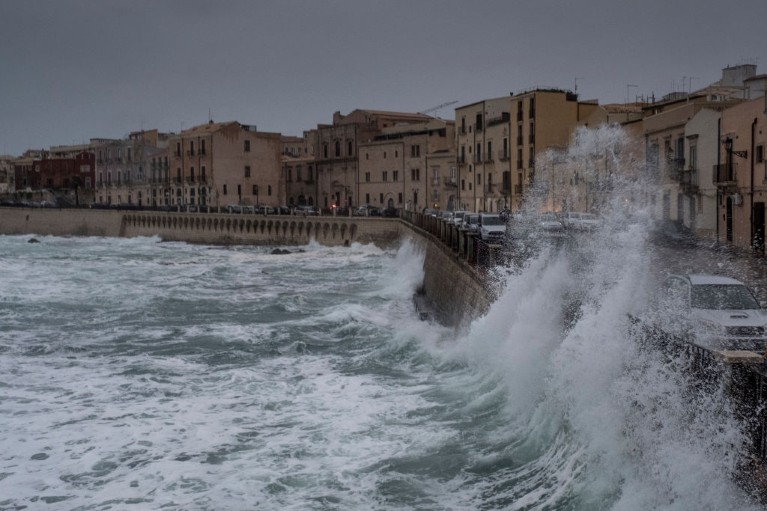28 October 2021. Huge waves hit the quayside of the peninsula of Ortygia hours before the Medicane hits land on October 28, 2021 in Syracuse, Italy. Credit: Sanne Derks/Getty Images News
According to the European Severe Weather Database, Italy was hit by 1499 extreme weather events in 2020 compared to 380 extreme weather events in 2010. They epitomize what is at stake in the COP26 negotiations starting this week in Glasgow, organized by Italy and the United Kingdom. Nature Italy discussed the changing climate with Donatella Spano, a professor at the Department of Agriculture at Università di Sassari, and a senior member of the Strategic Council of the Euro Mediterranean Centre on Climate Change (CMCC).
What do recent extreme events say about Italy’s vulnerability in the future?
Future scenarios tell us that such situations will intensify if no action is taken. More intense rainfall, increase in temperatures, more consecutive days without rain, heat waves, will all affect the Italian territory, with negative effects for agriculture, forests, and even the hydrological system. And of course, consequent social, economic and health risks. The whole territory is exposed, but with differences depending on the geographical area. What is happening in Sicily is a good example.
How will a warmer climate affect agriculture and forests in Italy?
Rising temperatures and a change in the distribution of rainfall influence the life cycle of plants, the welfare of livestock and water availability. We are already witnessing a reduction in yields, especially for crops with a spring-summer cycle such as corn or wheat. But we must consider that Italy is a peninsula, that has different geographical and climate characteristics. There are regions in the south that are more prone to drought than the northern parts, and this also increases the water requirements of crops. In general, models tell us that crops could benefit from the fertilizing effect of an increase in the concentration of CO2 in the atmosphere. But this is true only if water resources are available and soil fertility is kept high. Where climate change causes an increase in temperatures and a change in the rainfall regime, it is difficult to maintain what we call production factors, i.e., water availability, nutrients or control of the spread of pathogens. As far as forests are concerned, we’re already experiencing an increase in fire risk, up to 20%, and a lengthening of the fire season. There is also an increase in the area covered by fire, especially in the south where the vegetation is drier and more flammable.

Donatella Spano
You recently co-authored a study on the climate risks of six Italian cities. Most modelling studies are done at the regional or global level. How did you achieve that level of detail?
Urban systems are very complex, and in order to understand what their hotspots are it is necessary to have such a detailed analysis. We combined data from several sources and used climate and physical modeling to reach a resolution of two kilometers, for example showing which areas in each city are more exposed to flooding, or where ‘heat islands’ are located. This can provide tools for urban planning, for example by showing which areas need special protection for the population, or if it is better not to build houses in an area and allocate it to other activities. We started this study with the most populated cities, and with Venice for its cultural value, but we plan to continue with other cities.
This year’s Nobel Prize for physics went to climate modellers. What did it mean for climatologists, and what are the Italian contributions to the climatology community?
This Nobel prize is very important for helping people believe in the soundness of climate science, which I see as a pillar of our future together with health. In Italy, we have managed particularly well to combine the physical study of temperature, precipitation and other indicators with applied sciences, biology and engineering. If we want to study agriculture, forests, water or hydrogeological instability, all these sciences can no longer work separately. The creation of the CMCC had this purpose, and the Italian Society of Climate Sciences also has this interdisciplinary aspect.
There is often a doomsday narrative on climate issues, suggesting that the situation is so dramatic that it may be too late to act. Do you think it is effective?
It is not effective and it is wrong, it is not too late to act. We have to act now though. The G20 in Rome and COP26 are two crucial political passages in this sense, and the scientific community has a responsibility to deliver clear and correct messages to politicians. Ahead of the G20, for example, we [at the CMCC] have published an Atlas highlighting impacts and risks for the 20 member countries. This is without a doubt the decisive COP, and from a scientific point of view it is important that negotiations consider the intermediate scenarios [rather than only the worst-case] in order to push climate action and mitigation.
